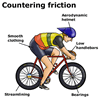Moving always seems to involve forces. In this module, you will investigate the scientific phenomenon of motion, and how it affects you in everyday life.
Moving and stopping
 All
objects have the tendency to stay where they are, or to continue moving
without changing motion unless there is an external force applied. This
is Newton's first law of motion, put forward by (Sir) Isaac Newton in
the late 1600s. You certainly know that things tend to stay put until
a force is used to move them - just think of a broken down car on a flat
stretch of road! The other part makes less sense. Why is it that if you
are cycling on a flat stretch of road you have to pedal to keep to the
same speed? In the mid 300s BC, Aristotle thought that an object only
continued to move while a force was applied, and this made sense from
his observations. Why does the bicycle slow down? It's all to do with
friction.
All
objects have the tendency to stay where they are, or to continue moving
without changing motion unless there is an external force applied. This
is Newton's first law of motion, put forward by (Sir) Isaac Newton in
the late 1600s. You certainly know that things tend to stay put until
a force is used to move them - just think of a broken down car on a flat
stretch of road! The other part makes less sense. Why is it that if you
are cycling on a flat stretch of road you have to pedal to keep to the
same speed? In the mid 300s BC, Aristotle thought that an object only
continued to move while a force was applied, and this made sense from
his observations. Why does the bicycle slow down? It's all to do with
friction.
Friction - bad and good
Friction affects objects moving on surfaces or through fluids (which can
be liquid or gas) such as water and air. It's one of the "external
forces" referred to by Newton. The bicycle slows because of friction
between the tyres and the road, between gears, chains and sprockets and
even the air pushing against the rider. All this means that more energy
needs to be put in by the rider to apply a large enough force to overcome
the combined forces of friction.
 There is a positive effect of friction as well. Friction between
the tyres and the road moves the bicycle forward - you know what happens
when friction is reduced, by oil or ice on the road, you slip and slide!
Friction is also necessary when you use the brakes to slow down. Friction
is reduced by oiling bearings, reducing wind resistance by getting low
over the handlebars, and even by the shape of the helmet.
There is a positive effect of friction as well. Friction between
the tyres and the road moves the bicycle forward - you know what happens
when friction is reduced, by oil or ice on the road, you slip and slide!
Friction is also necessary when you use the brakes to slow down. Friction
is reduced by oiling bearings, reducing wind resistance by getting low
over the handlebars, and even by the shape of the helmet.
Gravity
A major force involving motion is the gravitational force, the force tending
to pull all objects towards the centre of the Earth. If you drop something,
such as a pen, from your desk it falls to the floor then stops again.
This brings you to Newton's second and third laws of motion (there are
only three!) When the pen drops the existence of the gravitational force
and Newton's second law tells us that the pen will accelerate towards
the floor. The further the distance the pen falls, the greater its speed
will be.
 When the pen hits the floor it slows to a stop. It slows because
the force of the floor pushing up is greater than the gravitational force
on the pen. When the pen is stationary the force upwards from the floor
is equal to the gravitational pull of the Earth on the pen.
When the pen hits the floor it slows to a stop. It slows because
the force of the floor pushing up is greater than the gravitational force
on the pen. When the pen is stationary the force upwards from the floor
is equal to the gravitational pull of the Earth on the pen.
Gravity applies to anything on Earth, not just falling objects. That's the reason that if you throw a ball straight up in the air, or at an angle, it always comes back down again.
| Copyright owned by the State of Victoria (Department of Education and Early Childhood Development). Used with Permission. |